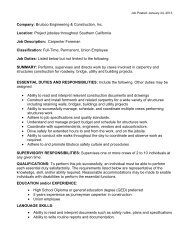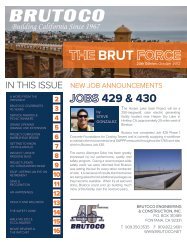Brut Force -14th Edition - Brutoco
Brut Force -14th Edition - Brutoco
Brut Force -14th Edition - Brutoco
- No tags were found...
You also want an ePaper? Increase the reach of your titles
YUMPU automatically turns print PDFs into web optimized ePapers that Google loves.
Mess #2:POWERLAY NEW PIPES WITHOUT DIGGINGTRENCHESTask:Deal with 240,000 annual water-main breaks more quicklyby using simple slide-in linersStatus: Thousands of feet of pipe repaired since MarchAnother way of fixing broken pipe without summoning the backhoes is tocoat it with a new inner lining -already common today in sewage pipes,which are under less pressure because they rely on gravity to move theircontents along. But Missouri-based Insituform Technologies’ newInsituMain liner can withstand the internal forces of pressurized pipe,allowing in-place repair of drinking water mains. Instead of a full-lengthtrench, two access points (up to 700 feet apart) are cut on either side ofthe broken pipe. Then workers insert at one end a flexible liner madefrom a felt-and-glass-fiber composite and soaked in thermosetting epoxyresin and pull it through the inner walls of the crumbling pipe. Exposingthe liner to steam or hot water stiffens and seals it, leaving it flush withthe inside of the pipe.Mess #3:WATERA NEIGHBORHOOD-SIZED SALTWATERPURIFIERTask: Decentralize our clean-water systemStatus: Prototypes now; commercial units within a yearYoram Cohe, a University of California at Los Angeles chemicalengineer, as a solution for thirsty communities in states like California,which burns 20 percent of its power treating and pumping in waterfrom far-off high grade reservoirs: to spread out the task. Histanning-bed-size reverse-osmosis machines could be deployed up anddown the coast, with each unit tapping into the ocean to provideneighborhoods with about 5,000 gallons of drinking water per day.The units carry software that ca fine-tune filtering in response to localchanges in water temperature, salinity, pH and silt, and can beremotely controlled from a central operations center.CLEAN WATER LIKE PLANTS DOADD STORAGE TO THE GRIDTask: Build plants full of spinning drums that storeelectricity, so we can finally save surplus energyStatus: 10-megawatt plant under construction inStephentown, N.Y.Incredibly, today’s grid has practically no storage capacity. The electricitycoming out of your socket was generated less than a millisecond ago, sopower plants have to continually generate enough energy for the biggestspikes. To prepare for the power fluctuations endemic to renewableenergy, we’ll need to inventory excess power to use during cloudy,windless afternoons and nights. The Massachusetts-based companyBeacon’s Power solution is to store the grid’s surplus energy in hundredsof spinning carbon-fiber-and-fiberglass drums. Each of its Generation 4flywheels features a 2,500-pound rotor mounted on magnetic bearingsand sealed in a vacuum to create a near-friction-free environment.Energy coming in from the grid accelerates the three-foot rotor to 16,000rpm (about Mach 2), where it keeps spinning with at least 97 percentefficiency. To pump energy back into the grid, some of the rotationalenergy is bled off to power a generator of the main shaft. Each flywheelcan store a 15-minute, 100-kilowatt charge and can discharge 150,000times over 20 years.MAKE ENERGY LIKE PLANTS DOTask: Convert sunlight into chemical energyStatus: Last year, scientists found a plentiful raw material that can freeoxygen from waterSolar panels are not the only energy-harvesting strategy under the sun. Foryears, scientists have also been trying to do what plants do – use sunlightto photosynthesize fuel. Until now, most approaches relied on impracticallyscarce materials like iridium as a catalyst that triggers the reaction. But lastyear, researchers at Lawrence Berkeley National Laboratory figured out howto use cobalt oxide, one of the most abundant industrial catalysts. Toovercome the relative inefficiency with which cobalt oxide uses sunlight tocrack water molecules and free the oxygen, researchers layered the catalyston a tightly stacked scaffold that makes it effectively 1,600 times asefficient. The net result: Arrays of cobalt-oxide panels that provide a steadysupply of oxygen, protons and electrons. The next goal is to find a similarlyefficient second catalyst to transform the by-products into an energy-densefuel like methanol to give gasoline a run for its money.Task: Treat our water on fewer terawattsStatus: First small-scale versions by 2011Plants pull water into their roots by osmosis, usingtiny channels called aquaporins, a method that doesn’t require anyenergy. Now a Danish company called Aquaporin is developing amembrane based on that same principle to extract pure H20 fromsaltwater at about a third of the cost and a tenth the energy ofconventional reverse-osmosis systems. The mebranes’ proteinchannels, each a few nanometers across, allow a stream of watermolecules – and only water molecules – to pass a single file at a rateof one-billion per second. No pumps needed to force water acrosschannels.Mess #4:SEWAGETURN SLUDGE INTO ELECTRICITYTask: Reduce the energy we use to treat wastewater, currently 1.5percent of our national power.Status: Field-testing reactors; commercial units by 2015.Bruce Logan, a professor of environmental engineering at Penn StateUniversity, has designed a microbial fuel cell to turn the chemicalenergy in sewage directly intoelectricity—and clean the sewage in theprocess. Bacterial housed on granitefiber anode break down the fats,proteins, and sugars in sewage, freeingup a steady stream of electrons, whichthe bacteria transfer directly into theelectode. Those electrons move to thecathode, providing electrical power, atthe cathode, producing hydrogen gas.Bright, Adam M. “ Renovating America” Popular Science February 2010The Future of Engineering p 38-45Illustrations by Paul Wootton19











